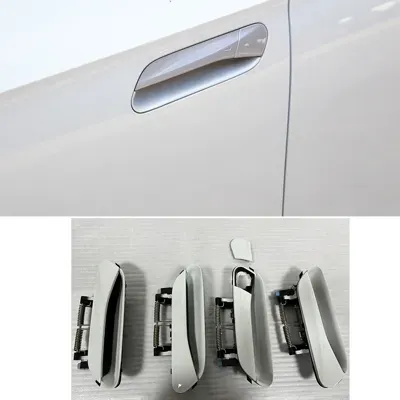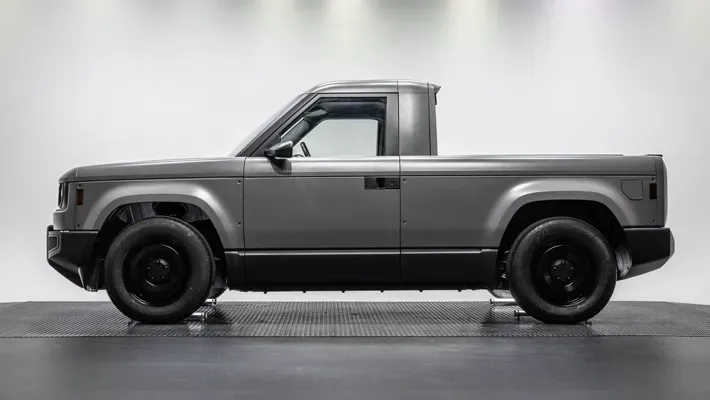Volkswagen door handles are at the center of a design debate that impacts both practicality and aesthetics. While many automakers, including Volkswagen, have experimented with sleek flush door handles in their vehicles, the feedback has been overwhelmingly critical. The brand now prioritizes functionality, realizing that customers favor usability over stylish designs that may impede their experience, especially in their electric vehicles like the upcoming ID. Polo. As electric vehicles gain more traction in the automotive market, ensuring user-friendly features like traditional door handles becomes essential for safety and convenience. Ultimately, Volkswagen’s commitment to enhancing automotive design reflects a deeper understanding of customer expectations and the importance of intuitive car interactions.
When discussing vehicle access solutions, the term “Volkswagen entry mechanisms” often emerges as a focal point in automotive discussions. These mechanisms play a crucial role, particularly in the evolving landscape of electric vehicles such as the ID. Polo and ID. Cross, where manufacturers explore various design innovations. Despite attempts at contemporary finishes, user experiences signal a preference for more conventional designs that simplify car safety and accessibility. As public interest in practical automotive features rises, automakers are reconsidering their approach to door handle designs, weighing traditional function against modern aesthetics while addressing consumer needs. Thus, Volkswagen’s shift to integrate recognizable and easy-to-use entry solutions captures the essence of customer-centered automotive design in today’s market.
The Challenge of Flush Door Handles in Modern Automotive Design
Flush door handles have gained traction in contemporary car manufacturing, primarily due to their sleek presentation that aligns with modern automotive design trends. However, as Volkswagen highlights, the practicality of these door handles often falls short of consumer expectations. While designers may prioritize aesthetic appeal, real-world functionality is paramount for drivers who seek ease of access in their vehicles. During the IAA Mobility show, it was emphasized that although flush door handles may enhance a vehicle’s visual appeal, they frequently result in frustrating user experiences when opening the car, particularly in urgent situations.
VW’s focus on integrating traditional, more accessible door handles into models like the ID. Polo and ID. Cross reflects a broader trend where car safety and user familiarity are prioritized. The importance of user-friendly features cannot be understated, especially as manufacturers strive to encourage broader adoption of electric vehicles. With customer feedback clearly stating a preference for practical designs over purely aesthetic choices, automakers like Volkswagen aim to harmonize engineering decisions with genuine user demands for comfort and speed.
Volkswagen’s Shift Towards Functional Door Handle Designs
Volkswagen’s decision to phase out flush door handles in favor of more conventional designs underscores a significant shift in the automotive industry’s approach to user experience. As echoed by Volkswagen’s CEO, Thomas Schäfer, customers expect intuitive operation from their vehicles, especially those investing in electric designs like the ID. Cross. By returning to traditional grab handles, VW is reinforcing its commitment to creating vehicles that fuse functionality with aesthetic integrity, which is crucial for gaining consumer trust amidst a wave of emerging electric models.
The design philosophy of prioritizing functionality over form is especially evident as Volkswagen approaches its electric vehicle initiative, which aims to make cars like the ID. Polo more recognizable and familiar to buyers. With a focus on applicable features that resonate with consumers, Volkswagen showcases a deeper understanding of consumer safety and comfort. This evolution not only positions the brand competitively in a crowded market but also emphasizes their dedication to improving the overall user experience in electric vehicles.
The Importance of User-Focused Design in Electric Vehicles
User-focused design has become increasingly important in the evolution of electric vehicles, where both functionality and safety are essential. Electric vehicles like the ID. Polo and ID. Cross need to balance innovative design with practicality, as consumers are often wary about new technologies. Volkswagen’s decision to implement conventional door handles highlights the significance of familiar features that enhance functionality. This shift aims to alleviate confusion and ensure ease of access, which is especially critical during emergencies, as highlighted by safety advocates in the U.S.
Moreover, the trend towards functional designs is likely to resonate well with a growing demographic of environmentally conscious consumers. These potential buyers desire not only a vehicle’s performance but also assurance that safety protocols are easily navigable. Volkswagen’s commitment to refining their designs by incorporating user feedback and simplifying operations ultimately supports the brand’s mission to produce vehicles that reflect customer priorities while still maintaining a focus on innovative automotive design.
Regulatory Considerations Affecting Door Handle Design
The global discourse surrounding automotive door handle design has reached regulatory heights, particularly regarding flush handles. In China, regulators are contemplating a ban on complicated door mechanisms due to safety concerns. Similarly, U.S. safety advocates have voiced their disapproval over how complex designs hinder emergency responders’ access during critical moments. As a result, automotive manufacturers like Volkswagen find themselves at a creative crossroads, balancing innovative design elements with compliance to regulatory standards that prioritize public safety.
These discussions around door handle regulations are crucial as the industry progresses towards more streamlined designs in electric vehicles. Volkswagen’s ability to navigate these regulatory waters will likely dictate its success in launching new models. As seen with the ID. Polo and ID. Cross, the ability for automakers to adapt to safety critiques could enhance consumer loyalty and trust, paving the way for continued innovations in electric vehicle design without compromising user access and safety.
The Trade-Off Between Design and Functionality in EVs
One of the most prominent debates in automotive design is the trade-off between aesthetics and functionality, particularly in electric vehicles. Flush door handles may reduce drag and improve the overall range of an electric vehicle, but Volkswagen’s recent statements reveal that these advantages come at a significant cost to user experience. The marginal efficiency gained from these sleek designs is not worth the frustration they cause to customers who expect straightforward interactions with their vehicles.
As electric vehicle adoption continues to rise, manufacturers must consider design choices that respect both the technical needs of a vehicle and the real-life usability for consumers. Volkswagen’s strategy of incorporating traditional handles into the ID. Polo and ID. Cross is indicative of a larger trend where functionality is prioritized without simply adhering to the latest design fads. Such decisions demonstrate the brand’s commitment to evolving alongside consumer feedback and operational demands, ensuring that their models remain appealing and practical.
Navigating Consumer Expectations with Volkswagen’s Electric Vehicles
With the growing landscape of electric vehicles, consumer expectations are evolving rapidly. Volkswagen’s engagement with customers has outlined a clear demand for intuitive vehicle designs that do not sacrifice usability for visual appeal. As evidenced by Thomas Schäfer’s insights during industry discussions, it’s apparent that customers appreciate familiarity and ease, especially when it comes to elements like door handles. This understanding aids VW in navigating consumer expectations by focusing on practical features that enhance the overall driving experience.
As the market shifts towards electric alternatives, Volkswagen is strategically positioning its models like the ID. Polo to align with contemporary consumer needs. Emphasizing accessible designs alongside modern automotive advancements speaks to an intentional focus on creating vehicles that are not only technologically advanced but also resonate deeply with user sensibilities. This approach reinforces the idea that fulfilling customer expectations is integral to the brand’s success in the electric vehicle market.
The Future of Door Handles in Electric Vehicles
Looking ahead, the future of door handles in electric vehicles is undergoing significant transformation. As manufacturers innovate, there will be a balancing act between maintaining modern aesthetics and guaranteeing user-friendly designs. Volkswagen’s pivot towards traditional handles serves as a case study on how companies can incorporate consumer feedback responsibly, steering their design choices towards more practical solutions that enhance user experience without compromising on the futuristic feel that electric vehicles aim for.
The exploration of door handle variability will likely continue, prompting manufacturers to refine features that both meet regulatory demands and align with user expectations. As seen with Volkswagen’s emphasis on integrating conventional handles, the evolution of door mechanics in electric vehicles should prioritize safety and functionality—all while ensuring that brands remain forward-thinking in their design strategies. This adaptability will be a hallmark of successful automotive brands in the rapidly changing landscape of electric mobility.
Car Safety and the Role of Door Handle Accessibility
Car safety is not merely about crash scores or protective features; it encompasses user accessibility as well, particularly concerning door handles. Reports indicate that automobile emergency responders struggle with complicated or malfunctioning door handles, potentially jeopardizing safety during critical moments. Automakers must prioritize the ease of access to ensure that both drivers and passengers can exit or enter the vehicle quickly and safely. Volkswagen’s return to traditional designs for their electric vehicles aligns with improved safety measures by opting for accessible door mechanisms.
Practical approach to door handle design speaks volumes in the automotive industry, as customers increasingly demand high safety standards alongside sleek appearances. Volkswagen recognizes this evolving narrative by addressing the critical feedback on their flush handles, steering their future designs towards solutions that fulfill both safety needs and consumer preferences. In the competitive landscape of electric vehicles, prioritizing car safety through accessible design is imperative for maintaining the trust and loyalty of buyers.
The Impact of Consumer Feedback on Automotive Innovation
Consumer feedback plays an invaluable role in shaping automotive innovation, particularly as brands like Volkswagen navigate the complexities of design and functionality in electric vehicles. The current shift away from flush door handles toward more accessible options is a direct response to customer critiques, emphasizing the importance of listening to end-users. It’s not enough for manufacturers to deliver eye-catching designs; they must also cater to practical usability that enhances the consumer experience.
This responsive approach to consumer insight not only reinforces customer satisfaction but also drives the industry towards more effective designs that resonate with modern expectations. As automotive design continues to innovate, incorporating feedback can lead to breakthroughs that not only address consumer concerns but also push the boundaries of what is feasible in terms of vehicle performance and aesthetics. Volkswagen’s transition aims to create a win-win situation: producing safe, functional, and visually appealing vehicles that meet the needs of an evolving market.
Frequently Asked Questions
What are flush door handles and why does Volkswagen critique them?
Flush door handles are designed to sit flush with the vehicle’s body, creating a sleek aesthetic. However, Volkswagen critiques them for being ‘terrible to operate,’ as they can be difficult for users to engage with in real-life scenarios, particularly for first-time users.
Why is Volkswagen moving away from flush door handles in its electric vehicles?
Volkswagen is moving away from flush door handles in its electric vehicles like the ID. Polo and ID. Cross based on customer feedback that prioritizes functionality over aesthetics. The brand aims to make door handles intuitive and familiar, ensuring ease of use for all drivers.
How do flush door handles affect automotive design and functionality?
While flush door handles contribute to a modern and streamlined automotive design, they can hinder functionality. According to Volkswagen, customers prefer traditional handles that provide intuitive operation, as their functionality is crucial for enhancing car safety.
What safety concerns have been raised regarding flush door handles?
Safety advocates have raised concerns that complex or malfunctioning flush door handles may hinder emergency responders from quickly accessing vehicles. Volkswagen recognizes this feedback and is moving toward more conventional designs to improve accessibility in its models.
How does the design of door handles influence the range of electric vehicles like the ID. Polo?
While flush door handles can reduce air drag and may enhance the overall range of electric vehicles, the improvement is marginal—approximately one mile. Volkswagen believes that prioritizing usability in door handle design will ultimately benefit customers more than minimal range increases.
What are the traditional handle designs in upcoming Volkswagen electric vehicles?
The designs for upcoming Volkswagen electric vehicles like the ID. Polo and ID. Cross feature traditional grab handles instead of flush types, reflecting the brand’s commitment to customer feedback and prioritizing user-friendly functionality in their automotive design.
Will Volkswagen continue using complex door handle designs in its future models?
No, Volkswagen has stated its commitment to using more conventional, user-friendly door handles in future models. This decision comes after considerable feedback indicating that customers prefer practicality and familiarity in their vehicle features.
What has Volkswagen stated about the importance of vehicle familiarity for customers?
Volkswagen has emphasized that customers expect a certain level of familiarity with their vehicles, including intuitive features like door handles. The company aims to enhance vehicle recognition and user experience for its electric vehicle lineup.
How do Volkswagen’s recent changes in door handle design reflect broader trends in automotive safety?
Volkswagen’s shift towards traditional door handle designs reflects a broader trend in automotive safety, where ease of access and functionality are critical. This change addresses safety concerns raised by regulators and advocates about complex handle designs.
What is the connection between door handle design and overall vehicle functionality in the automotive industry?
The design of door handles directly impacts vehicle functionality and customer satisfaction. Volkswagen’s focus on proper door handles signifies a shift towards prioritizing customer needs and safety over mere aesthetics in automotive design.
| Key Point | Details |
|---|---|
| Flush Door Handles Critiqued | Volkswagen criticized flush door handles for being difficult to operate despite their sleek design. |
| Customer Feedback | Volkswagen has received significant feedback indicating that customers prioritize functionality over aesthetics. |
| New Door Handle Design | Upcoming models like the ID. Polo and ID. Cross will feature ‘proper’ door handles, moving away from flush designs. |
| CEO’s Vision | CEO Thomas Schäfer emphasizes the need for intuitive operation and intends to simplify vehicle interactions. |
| Safety Concerns | Concerns have been raised about the difficulty emergency responders face with complex door handles. |
| Performance Considerations | While flush handles reduce drag, the impact on range is minimal, leading to questions about their practicality. |
Summary
Volkswagen door handles have become a focal point of discussion due to their functionality versus aesthetic appeal. The brand is pivoting towards more traditional designs, acknowledging that while flush handles look appealing, they often fail to meet user expectations. Feedback from customers has highlighted a clear preference for practicality over style, prompting Volkswagen to ensure that future models, particularly electric vehicles like the ID. Polo and ID. Cross, will feature easily operable door handles. This commitment reflects a broader trend within the automotive industry to prioritize user experience and safety, especially as regulatory scrutiny around complex door mechanisms intensifies.



























